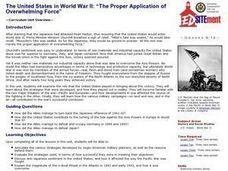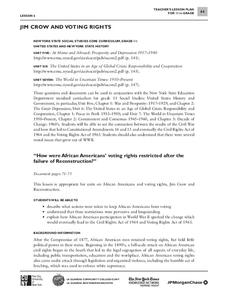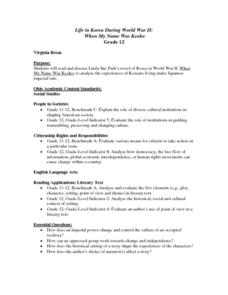Curated OER
Introduction to the Holocaust
Students examine the events surrounding the Holocaust in World War II. After viewing a clip from "The War", they work together in groups to research the various responses from governments on the tradegy. To end the lesson, they write a...
Curated OER
Letters From the Front Lines
Students read a variety of letters from soliders who were on the front lines during World War II. After viewing an excerpt from "The War", they answer discussion and comprehension questions based on the letters and video. To end the...
Curated OER
The Perilous Fight: WWII - Up Close and Personal
Students research World War II primary source documents and write first person historical point of view stories.
Curated OER
The Daytime D-Day Hour: Producing a D-Day Talkshow
Students analyze the key players and events of D-Day during World War II. They conduct research on an assigned character's role in D-Day, complete worksheets, and plan and participate in a D-Day talk show, presenting information in a...
The Formation of the Western Alliance, 1948–1949
Silence is golden—even when debating post World War II foreign policy. Using a silent debate format, young historians deliberate whether the United States should have kept a foothold in West Germany after World War II. A series of videos...
Curated OER
"The Proper Application of Overwhelming Force": The United States in World War II
Students examine the role that the U.S. played in bringing about victory in the two major theaters of the war in the Pacific and Europe. How the various military campaigns contributed to the war's successful conclusion forms the focus of...
National Endowment for the Humanities
The Strategy of Containment, 1947–1948
How do people stop the spread of an ideology they don't think is right? Scholars research the policy of containment during the start of the Cold War. Small groups analyze primary sources to determine how the United States combated...
National Endowment for the Humanities
The Rise and Fall of Joseph McCarthy
"I have here in my hand . . ." The war against Communism and Joseph McCarthy’s place in it are the focus of a series of lessons examining postwar America from 1945-1954. Joseph McCarthy takes center stage in this, the final lesson of the...
National WWII Museum
Pearl Harbor: Analyzing FDR's Pearl Harbor Address
FDR's words calling the attack on Pearl Harbor a "day in infamy" have been immortalized. Learners use analysis and discussion questions to consider the origins and drafting of the famed speech that brought the United States into World...
Curated OER
Decoding Nazi Secrets
Students practice decoding messages given the key. They continue to practice solving messages without a key. They must determine the best way to view the message. They examine secret messages during World War II.
Curated OER
Japanese-American Internment: The Art of Gaman
High schoolers explore Japanese-American internment. In this World War II lesson, students view a PowerPoint lecture that features the art of Gaman and determine what the art reveals about the experiences of the interned Japanese-Americans.
Curated OER
Changing Perspectives on the Japanese Internment Experience
High schoolers explore the issue of Japanese-American internment. In this World War II lesson, students analyze historical biases regarding Japanese-American internment as they analyze literature, research print and Internet sources, and...
City University of New York
Jim Crow and Voting Rights
Class groups examine primary source documents to determine how the voting rights of African Americans were restricted after the failure of Reconstruction, and how African American participation in World War II lead to change.
National WWII Museum
Dr. Seuss and WWII
What famous children's author and illustrator created World War II political cartoons featuring such subjects as fascism, the war effort, discrimination, and the dangers of isolationism? The who in this story is Dr. Seuss, and what...
US Holocaust Museum
Life in Shadows: Hidden Children and the Holocaust
Hiding in the filth of a sewer, as a child, to avoid capture by Nazi soldiers—sounds scary! Scholars investigate the youngest victims of the Holocaust, the children. They research video clips and written sources from the Holocaust...
Little Kids Rock
The Influence of Latin Music in Postwar New York City
Music has often been called the international language that transcends cultures and regions. Scholars analyze the impact of Latin American music on New York City culture in the years following World War II. They research music, video,...
National WWII Museum
The Red Ball Express: Statistics as Historical Evidence
Historians use all kinds of information to make conclusions ... including statistics. Young scholars examine how two historians evaluate The Red Ball Express—a supply line staffed primarily by African Americans—using numbers. The...
Curriculum Development Institute
Factors for Economic Integration in Western Europe since 1945
While the European Union has been a part of economic landscape for decades, it grew out of a period of economic integration after World War II. Using a round table method, class members analyze and discuss the events leading up to the...
Facing History and Ourselves
A Scene from a Middle School Classroom
Citizens in the modern world can't imagine making the same social choices made by many Germans in the 1920s and 1930s, but they don't realize that they actually do it every day by ostracizing others. A case study of middle schoolers...
University of Southern California
Coming to America After the War
As part of their exploration of the American dream, class members examine primary source materials to compare immigrant experiences of those arriving early in our country's history to those arriving in the US after World War II. To...
Curated OER
Basil Heatter, "The Long Night of the Little Boats"
“It was a miracle.” Basil Heatter’s “The Long Night of the Little Boats,” which details the miraculous rescue of the British army from the shores of Dunkirk in 1940, is featured in a series of exercises that ask class members to read,...
Curated OER
Oral History of World War II
Students research how citizens from the United States respond to the onset, duration and aftermath of World War II. They view clips from the movie "Swing Shift" and discuss the roles of civilians, minorities and military personnel. They...
Curated OER
Life in Korea During World War II: When My Name Was Keoko
Twelfth graders review facts about roles of Asia and Japan in World War II, read When My Name Was Keoko to familiarize themselves with daily life and historic events during World War II in Korea, and participate in student-led...
Curated OER
Gunpowder And The Explosion Of World War
Students discover the role of technology in 20th century conflicts. In this technological advancement lesson, students research how World War I, World War II, Vietnam, and the War in Iraq were fought. Students compose essays that...
Other popular searches
- Causes World War Ii
- World War Ii Map
- World War Ii Holocaust
- World War Ii Battles
- Post World War Ii
- Propaganda World War Ii
- Causes of World War Ii
- World War Ii Newspaper
- World War Ii Veterans
- Allies in World War Ii
- World War Ii Geography
- Post World War Ii Asia

























